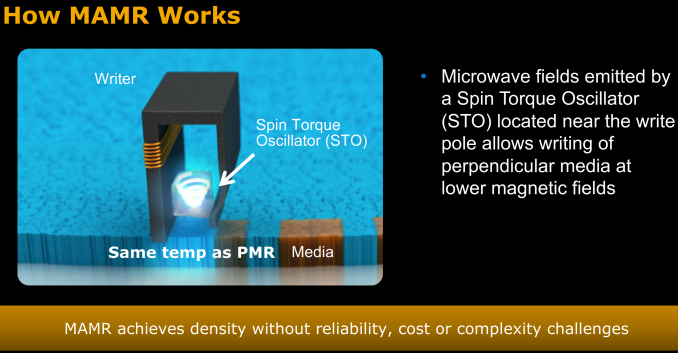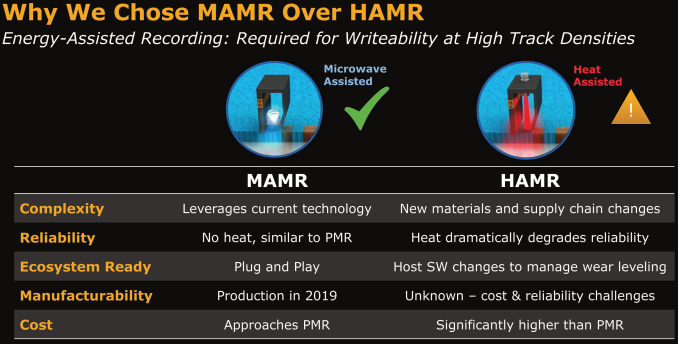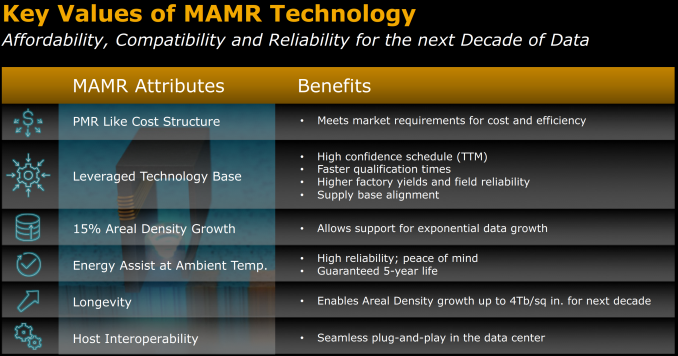Western Digital Stuns Storage Industry with MAMR Breakthrough for Next-Gen HDDs
by Ganesh T S on October 12, 2017 8:00 AM ESTMicrowave Assisted Magnetic Recording (MAMR)
The WD Breakthrough
Western Digital's Microwave Assisted Magnetic Recording (MAMR) drives use platters very similar to those in the current-generation PMR drives*. This means that the innovation to enable MAMR is mainly to do with the heads that perform read and write operations.
As part of the MAMR design, WD pointed out to its shift to the damascene process for building the bit grains as the key enabler for the MAMR breakthrough. The process allows them to fabricate a spin torque oscillator (STO) capable of creating precise energy fields without any additional overheads. The embedded oscillator in the head is tuned to generate microwaves with a frequency of 20-40 GHz, and this provides the 'energy-assist' to make it easier to write to the bits (technically it lowers the coercivity of the underlying recording media).
* Current drives use an aluminium substrate with a cobalt-platinum layer.
WD pointed out that MAMR requires absolutely no external heating of the media that could lead to reliability issues. The temperature profiles of MAMR HDDs (both platters and drive temperature itself) are expected to be similar to those of the current generation HDDs. It was indicated that the MAMR drives would meet all current data center reliability requirements.
Based on the description of the operation of MAMR, it is a no-brainer that HAMR has no future in its current form. Almost all hard drive industry players have a lot more patents on HAMR compared to MAMR. It remains to be seen if the intellectual property created on the HAMR side is put to use elsewhere.
Western Digital has talked about timeframes for the introduction of MAMR drives. They had working prototypes on display at the press and analyst event yesterday. WD's datacenter customers have their own four to six month qualification cycle, and MAMR drives for that purpose are expected to be out towards the middle of next year. Production-level HDDs based on MAMR technology are expected to start shipping in 2019.
Western Digital sees plenty of value in MAMR, and it is not hard to see why. MAMR technology allows for the bit densities of individual platters to scale to more than 4 Tb/sq.in. WD believes that it is well-positioned to bring 40TB drives by 2025 using MAMR alone.
Technologies such as SMR and TDMR are complementary to MAMR. Currently, WD does not use TDMR in any shipping enterprise drive, and SMR is restricted to a few host-managed models. It is possible that some MAMR drives will use those technologies to achieve higher capacity points compared to conventional drives. WD's working prototype on display was a helium drive (HelioSeal), but, WD again stressed that helium is not a compulsory requirement for MAMR drives. It was also confirmed that drives of 16TB and more would have to be MAMR-based.
In 2005, when the shift from longitudinal recording to PMR happened, most vendors managed to release drives based on the new technology within a few years of each other. The shift to helium in 2012, though expected by everyone in the industry, proved to be a big win for HGST - they had the markets that focus on high-capacity, or low-power, or low TCO to themselves for almost three years before Seagate eventually caught up. Toshiba is yet to release a helium drive publicly. It is going to be interesting to see how Seagate and Toshiba respond to this unexpected MAMR announcement from Western Digital.
The players in the hard drive industry have a robust cross-licensing program, and it is highly likely that other manufacturers will not face significant patent bottlenecks in bringing out MAMR drives on their own. WD stressed that the development is a multi-year effort, particularly if the heads are still being manufactured in the old dry pole process.
High-volume mature hard drives are often manufactured with the help of third-party suppliers - such as Showa Denko for the recording media and TDK for the heads. In the case of the MAMR drives, WD mentioned that all the components are being designed and manufactured in-house. It is possible for the competition to catch up faster if some of the third-party manufacturers are further along in their own R&D. In particular, TDK has been investing in MAMR R&D recently too. Toshiba has also shown interest in the same, but it is not clear how far along they are in the commercial development cycle. Currently, we believe WD has a clear lead in MAMR technology. It just remains to be seen how long it takes for the competition to catch up.














127 Comments
View All Comments
DanNeely - Thursday, October 12, 2017 - link
This's a pleasant surprise (cheaper bulk storage is always a win). Projections I'd seen from a year or two ago were projecting a mid 2020's point for flash becoming cheaper per TB than HDDs. I assume the high expected cost for HAMR was probably a major driving factor in those projections. If MAMR really will be as cheap to implement as current PMR solutions it's good news all around.MajGenRelativity - Thursday, October 12, 2017 - link
Agreedjjj - Thursday, October 12, 2017 - link
WD used to lie a lot less than others but those HDD vs SSD projections are hilarious, new CEO ,new habits i suppose.SSDs will go after nearline soon enough as they'll need to do that to offload all the bits produced.
Anyway, interesting tech but too late to matter much and that's a pity.
melgross - Thursday, October 12, 2017 - link
It's going to take a heck of a long time before SSDs come close to the costs of HDD.While HDDs seem to have newer tech to enable more storage in the same space, SSD is relying on multilayering, which is now 64, but moving to 72. The idea of using smaller process diminution has ended, unless some unknown breakthrough occurs, which we can't expect, because there's nothing known to have us expect one. How many layers can be made? At some point, it won't be possible to go any higher.
But MAMR was understood to be a slight possibility, and WD has made that breakthrough. There's no reason to believe that the 40TB by 2025 shouldn't be believed since preproduction sampling will be next year, and production delivery will be in 2019. That's pretty quick.
Lolimaster - Thursday, October 12, 2017 - link
But 40TB on the top of the line for 2025 is still too low, considering near 10years of PMR stagnation.HAMR was supposed to give us 15-20TB by now, up to 50TB by 2020-2021 and up to 100TB in 2025.
melgross - Thursday, October 12, 2017 - link
Who are you to say it's too low? Are you doing research in this area to know that? Or do you just read articles on it and complain because it's not moving fast enough for you?AnnonymousCoward - Thursday, October 12, 2017 - link
Samsung says 128TB SSD in 2019.beginner99 - Friday, October 13, 2017 - link
The issue with SSDs is that there already is a shortage of flash. Flash is a semi-conductor and hence manufacturing is a bottleneck. Unless a significantly better alternative to flash is found, ssd will remain niche in terms of total storage amounts.someonesomewherelse - Saturday, October 14, 2017 - link
Cartel agreements you mean.shabby - Thursday, October 12, 2017 - link
And I'm sure when these are released they'll still be the same size like the current drives so wd can keep milking everyone.